
Jan Pauwel Gillemans the Elder [1] (Antwerp, 1618 - Antwerp, 1675) was a Flemish goldsmith and still life painter who is known for his fruit still lifes, flower pieces, vanitas still lifes and pronkstillevens. [2]

Jan Pauwel Gillemans the Elder [1] (Antwerp, 1618 - Antwerp, 1675) was a Flemish goldsmith and still life painter who is known for his fruit still lifes, flower pieces, vanitas still lifes and pronkstillevens. [2]
Jan Pauwel Gillemans the Elder was born in Antwerp as the son of Laureis and Clara van Baesel. His father was a goldsmith and a master of the Guild of Saint Luke of Antwerp. Gillemans was also destined to become a goldsmith and was sent to a family member in Liège to be trained in this craft. While this training included drawing, the young Gillemans wished to become a painter and returned to Antwerp after a stay of 7 to 8 years in Liège.

It is not known with whom he trained to become a painter. [3] He became a master of the Antwerp Guild of St. Luke as the son of a member in the guild year 1647/1648. [4]
In August 1648 Gillemans married Paulina Uyt den Eeckhout. The couple had four sons and four daughters. The needs of his large family forced the artist to open a gold shop. The deacon of the goldsmiths first refused to have him admitted as a goldsmith of the Guild but thanks to the intervention of Antwerp's city magistrate and the submission of his admission piece he was finally accepted in 1662. Gillemans did not abandon painting but continued to paint while running his gold shop. [3] From the records of the Antwerp art dealer Forchondt for the years 1665 to 1673 it is known that Gillemans regularly provided the art dealer with fruit still lifes and garlands with herrings or lobsters for the export. [2]
Gillemans died in Antwerp on 12 August 1675. [3]
He was the teacher of his son Jan Pauwel Gillemans the Younger and Jan Frans van Son, who was the son of the prominent still life painter Joris van Son. [2]

The known work of Gillemans is limited. [5] Gillemans was a specialist still life painter who is known for his heavy garlands with fruits and flowers set on a neutral background. He also painted pronkstillevens (i.e. sumptuous still lifes of luxurious objects), vanitas still lifes and garland paintings. [2] [5]
His work shows that he was in contact with the circle of Jan Davidszoon de Heem, a Dutch still life painter who was active in Antwerp from the mid-1630s. [5] Typical characteristics of his work are the studied compositions, beautifully harmonious colours, accurate depictions of various types of fabric and detailed displays of flowers and vegetables in all their diversity. [6]
Some of his works are pronkstillevens, the sumptuous still lifes that were popular in Flanders and the Dutch Republic from the 1640s. A representative example in this genre is the Pronk still-life with fruit and a lobster, a lute on a chair, a landscape seen through a colonnade beyond (At Christie's London on 3-4 July 2012, lot 152), which represents a table laden with fruit, a ham, a lobster, a lute on a chair all placed in front of a landscape visible beyond a colonnade. Pronk still lifes are often interpreted as having a vanitas meaning. [7]

His fruit still lifes of fruit and flowers were typically of a large format. A few were created on a smaller scale and were popular among contemporary collectors as cabinet pieces. An example is the Still life with lemons, grapes, a pipe and filleted fish (At Dorotheum Vienna on 9 April 2014, lot 566). This signed work shows that in the small format Gillemans preferred narrow views that put the focus on meticulously described objects. [8]
A number of his still lifes fall into the category of 'garland paintings'. Garland paintings are a type of still life invented in early 17th century Antwerp by Jan Brueghel the Elder and subsequently practised by leading Flemish still life painters, and in particular Daniel Seghers. Paintings in this genre typically show a flower or, less frequently, fruit garland around a devotional image or portrait. Garland paintings were usually collaborations between a still life and a figure painter. The figure painter would take care of the figures inside the cartouche while the still life painter was responsible for the flower or fruit garland. [9] The names of the collaborators of Gillemans on his garland paintings are not generally known but a collaboration with Thomas Willeboirts Bosschaert is presumed. [10] An example of Gillemans' work in this genre is the Garland of Flowers Surrounding a Cartouche Containing an Angel's Head and the Holy Sacrament (Victoria and Albert Museum). The garland includes thistles, grains, grapes and other flowers and fruit that allude to the Passion of Christ and to the Sacramental bread and wine of the communion which is depicted in the centre of the composition. [11]

Gillemans also painted vanitas still lifes, a genre of still lifes which offers a reflection on the meaninglessness of earthly life and the transient nature of all earthly goods and pursuits. An example is the composition Vanitas still life (Hermitage Museum). [12] This composition contains the typical symbolism of vanitas paintings: a crowned skull, a wilting flower, an hourglass, an empty glass and cup, and a book and money bags (symbolising the futility of mankind's higher and worldly aspirations). On a scroll of paper are written the words 'Omnia Vanitas', which refer to the famous line of the Ecclesiastes, which in the Latin version of the bible called the Vulgate 1:2; 12:8 is rendered as Vanitas vanitatum omnia vanitas. In the King James Version it is translated "Vanity of vanities, all is vanity". [12] [13] [14] This is one of the principal themes of vanitas paintings.
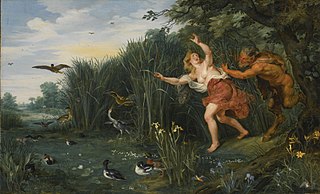
Jan Brueghelthe Younger was a Flemish Baroque painter. He was the son of Jan Brueghel the Elder, and grandson of Pieter Bruegel the Elder, both prominent painters who contributed respectively to the development of Renaissance and Baroque painting in the Habsburg Netherlands. Taking over his father's workshop at an early age, he largely painted the same subjects as his father in a style which was similar to that of his father. He gradually was able to break away from his father's style by developing a broader, more painterly, and less structured manner of painting. He regularly collaborated with leading Flemish painters of his time.

Jan Davidsz. de Heem or in-full Jan Davidszoon de Heem, also called Johannes de Heem or Johannes van Antwerpen or Jan Davidsz de Hem, was a still life painter who was active in Utrecht and Antwerp. He is a major representative of that genre in both Dutch and Flemish Baroque painting.

Adriaen van Utrecht was a Flemish painter known mainly for his sumptuous banquet still lifes, game and fruit still lifes, fruit garlands, market and kitchen scenes and depictions of live poultry in farmyards. His paintings, especially the hunting and game pieces, show the influence of Frans Snyders. The two artists are considered the main inventors of the genre of the pronkstillevens, i.e. still lifes that emphasized abundance by depicting a diversity of objects, fruits, flowers and dead game, often together with living people and animals. Van Utrecht also painted a number of flower still lifes. He was a regular collaborator with leading Antwerp painters who had been pupils or assistants of Peter Paul Rubens, such as Jacob Jordaens, David Teniers the Younger, Erasmus Quellinus II, Gerard Seghers, Theodoor Rombouts, Abraham van Diepenbeeck and Thomas Willeboirts Bosschaert.
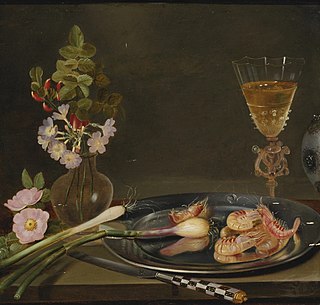
Frans Ykens was a Flemish still life painter active in Antwerp and Brussels in the 17th century. He is mainly known for his flower pieces and fruit still lifes and also painted banquet pieces, pronkstillevens, garland paintings and larger game pieces.

Pieter Thijs, Peter Thijs or Pieter Thys was a Flemish painter of portraits as well as religious and history paintings. He was a very successful artist who worked for the courts in Brussels and The Hague as well as for many religious institutions. His work was close to the courtly and elegant style of Anthony van Dyck and his followers.
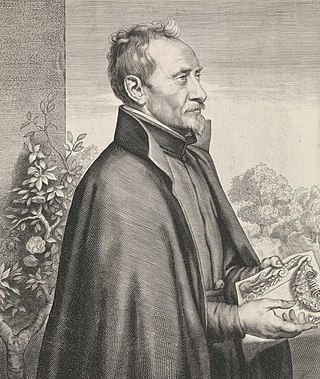
Daniël Seghers or Daniel Seghers was a Flemish Jesuit brother and painter who specialized in flower still lifes. He is particularly well known for his contributions to the genre of flower garland painting. His paintings were collected enthusiastically by aristocratic patrons and he had numerous followers and imitators.
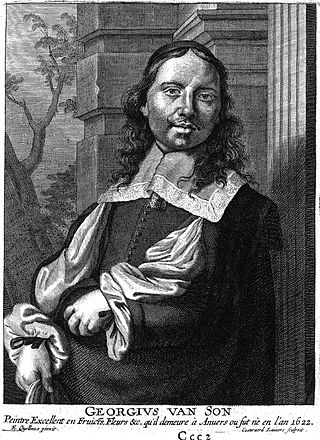
Joris van Son or Georg van Son was a Flemish still life painter who worked in a number of sub-genres but is principally known for his still lifes of fruit. He also painted flowers, banquets, vanitas still lifes and pronkstillevens. He is known to have painted fish still lifes representing the Four Elements, and also collaborated with figure artists on 'garland paintings', which typically represent a devotional image framed by a fruit or flower garland.

Alexander Coosemans was a Flemish Baroque painter specialized in still lifes of flower pieces, fruit, and inanimate subjects. He painted vanitas still lifes, pronkstillevens and game pieces.

Carstian Luyckx, also known as the Monogrammist KL, was a Flemish painter and draughtsman who specialized in still lifes in various subgenres including flower still lifes, fruit still lifes, fish still lifes, pronkstillevens, vanitas still lifes, hunting pieces and garland paintings. He also painted animals and a few genre scenes. After starting his career in Antwerp he is believed to have worked later in France.

Gysbrecht Thys or Gysbrechts Thys was a Flemish painter active in Antwerp known for his religious and mythological works as well as for his nudes. He also painted landscapes. Very few paintings have been attributed to the artist to date.

Jan Pauwel Gillemans the Younger was a Flemish still life painter. He worked in a range of still life genres including flower and fruit still lifes, banquet still lifes, pronkstillevens and hunting pieces. He collaborated with figure painters to create landscapes which combined a mythological or allegorical scene with a still life. He worked and lived in Antwerp, Middelburg, London and Amsterdam.

Jan Frans van Son or Frans van Son was a Flemish still life painter. The son of the prominent Antwerp still life painter Joris van Son, he trained with another prominent still life artist Jan Pauwel Gillemans the Elder. He left for England at a young age and had a successful career in London. He painted flower pieces, fruit still lifes and banquet still lifes.

Gaspar Peeter Verbruggen or Gasparo Pedro Verbruggen was a Flemish still life painter who is principally known for his decorative still lifes with flowers and fruit. He collaborated with figure artists on compositions which combined figures with a still life element. He was active in Antwerp and The Hague.
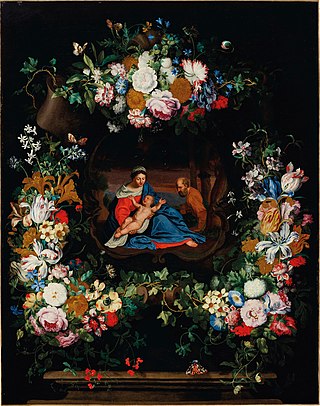
Jan Pieter Brueghel or Jan Peeter Brueghel was a Flemish painter who specialised in flower still lifes and garland paintings. A scion of the famous Brueghel family of painters, he trained in Antwerp with his father and later worked in Liège, Paris and Italy.
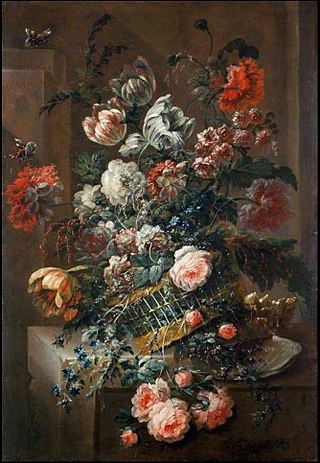
Jan Baptist Morel or Jean Baptiste Morel was a Flemish still life painter who specialized in flower pieces and garlands. He was a successful artist who worked in Antwerp and Brussels.

Peter Willebeeck or Petrus Willebeeck was a Flemish still life painter who was active in Antwerp in the second quarter of the 17th century. He is known for his fruit still lifes, vanitas still lifes, pronkstillevens and banquet pieces executed in a very delicate manner.

Frans van Everbroeck was a Flemish still life painter who is known for his fruit still lifes, vanitas still lifes and pronkstillevens. He was active in Antwerp, Amsterdam and London. The Dutch painters Abraham Mignon and Maria van Oosterwyck are regarded as his followers.

The Pseudo-Simons is the notname given to a painter presumed to have been active in Antwerp in the second half of the 17th century and the attributed author of 100 works, principally of fruit and flower still-lifes and pronkstillevens.

Andries de Coninck or Andries de Koninck was a Flemish art dealer and still life painter active in Antwerp. He is known for his pronkstillevens, the still lifes that were popular in Flanders and the Dutch Republic from the 1640s.
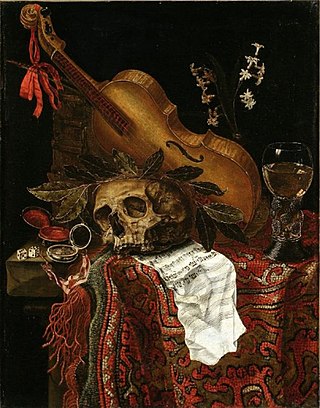
Peter van Kessel or Peeter van Kessel was a Flemish still life painter who worked in a number of sub-genres but is principally known for his flower pieces, game pieces, garland paintings and vanitas paintings. He trained in Antwerp but mainly worked abroad, and in particular in Northern Europe.